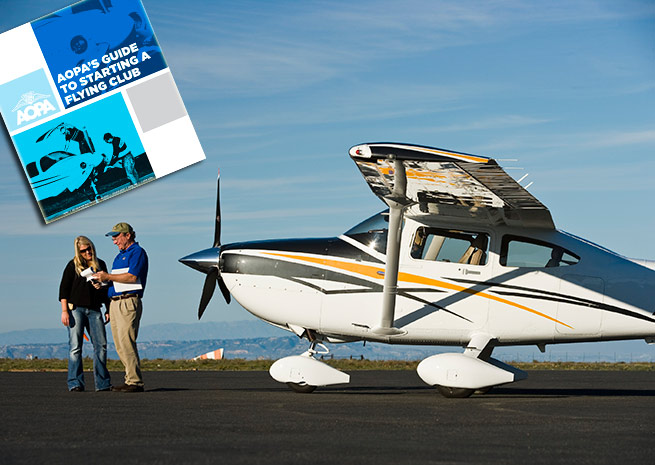 General aviation pilots are a diverse group, with numerous motivations and means to fly. One matter on which the pilot community speaks in broad agreement is on being part of a flying club: It is an overwhelmingly positive experience, pilots say. From the camaraderie of like-minded individuals and peer support toward training goals, to sharing and spreading costs, flying clubs—the more than 600 of them in the U.S—get the job done.
General aviation pilots are a diverse group, with numerous motivations and means to fly. One matter on which the pilot community speaks in broad agreement is on being part of a flying club: It is an overwhelmingly positive experience, pilots say. From the camaraderie of like-minded individuals and peer support toward training goals, to sharing and spreading costs, flying clubs—the more than 600 of them in the U.S—get the job done.
Recognizing how important flying clubs are to helping aviation thrive, on March 12 AOPA released AOPA’s Guide to Starting a Flying Club, a new, comprehensive tool to help members navigate the launch and operation of their own flying clubs.
"This guide was created to provide a useful roadmap to pilots starting a club," said Woody Cahall, leader of AOPA’s flying club initiative. "It addresses the biggest challenges about starting new flying clubs, and it provides commonsense advice pilots can apply when launching clubs, all around the country."
With chapter-by-chapter coverage of the essential topics, AOPA’s Guide to Starting a Flying Club takes the guesswork out of such important decisions as choosing the right aircraft and insurance coverage.
From financial management and legal issues to a club’s social nature, the publication in 11 chapters takes a club from start-up to day-to-day operations as a fully functioning organization. For reference, the guide provides sample documents, forms, and other useful resources including draft operating rules and aircraft lease agreements. It discusses the use of social media to promote and develop the organization, and emphasizes the importance of club events, meetings, and communicating with members to maintain cohesion and inspiration.
In 2012, AOPA conducted a survey of general aviation pilots that revealed that more than half of all active pilots are past or present members of a flying club—and that virtually all of them consider club membership an overwhelmingly positive experience.
The study also made abundantly clear that pilots fly more, pursue more training, and stay involved in aviation longer as members of a strong and cohesive local flying community.
For those reasons, AOPA is committed to help flying clubs flourish, and stands behind existing clubs through such efforts as the monthly AOPA Club Connector newsletter. It allows clubs to share information, resources, and best practices, and collaborate on issues of mutual interest. AOPA also offers pilots a way to find the nearest flying club to them through AOPA’s Flying Club Finder, provides extensive coverage of clubs, their members, and their activities and will continue working to expand other programs to make flying more accessible and affordable.
Additional resources
AOPA provides additional resources to help flying clubs get off the ground. They include a new program through the AOPA Aviation Finance Co. that offers up to 50 percent financing, with no personal guarantees, for established clubs and, on an exception basis, for larger start-up clubs. If a member of the flying club is able to guarantee the loan, AOPA Aviation Finance Co. has programs with up to 70 percent financing.
The AOPA Flying Club Insurance Program, offered by AOPA Insurance Services, makes it easy to manage a club’s insurance program no matter how many aircraft or members are involved. It offers flying clubs the ability to "stack" nonowner policy limits. This means that a club member who owns 20 percent or less of the club aircraft, and has significantly greater assets than other members can buy a nonowner policy, and have its policy limits "stack" on top of the club aircraft insurance policy limits. The feature provides a means for individual flying club members to secure the higher liability protections they desire or require. The program offers a level of policy customization never before found in a club policy.
The AOPA Flying Club Insurance Program also allows for special rates for clubs between three and 10 members (with flat rates available as needed for clubs that grow beyond that level).
The new AOPA Flying Club Insurance Program makes it easy to get insurance for clubs with more than 10 members, and it does not charge for "social members."



